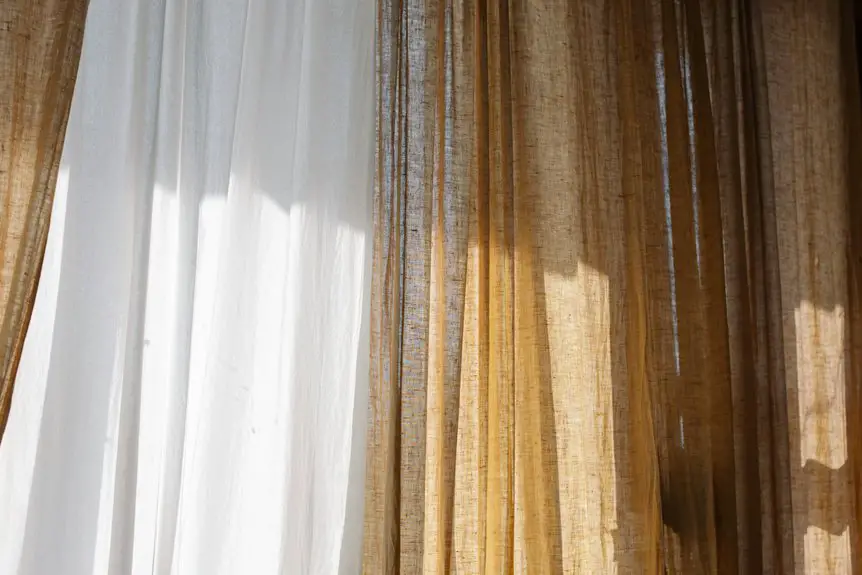If you choose linen-blend casement fabric for drapes, you get durability combined with natural elegance and excellent light control. It resists wrinkles better than pure linen but can still crease and may fade with prolonged sun exposure. It’s pricier and needs gentle care, though cleaning is easier than with 100% linen. This fabric suits layers and various décor styles well. Keep exploring if you want to discover more about maintenance tips and styling ideas.
Table of Contents
Key Takeaways
- Linen-blend drapes combine durability and elegance, offering long-lasting and visually appealing window treatments.
- They provide excellent light filtration and natural breathability, enhancing comfort and sunlight control.
- The fabric resists wrinkling but tends to crease easily, requiring occasional smoothing for a crisp look.
- Linen-blend can be pricier than synthetic fabrics and may fade or wear faster with prolonged sun exposure.
- Maintenance is easier than pure linen, with gentle washing recommended and regular dusting to preserve texture and color.
Benefits of Linen-Blend Casement Fabric for Drapes
Although you might find many fabric options for drapes, linen-blend casement fabric stands out for its unique combination of durability and elegance. When you choose this fabric, you get the natural breathability of linen paired with the strength of synthetic fibers, making your drapes both sturdy and lightweight.
You’ll appreciate how the blend resists wrinkling, so your curtains stay crisp without constant ironing. Plus, the texture adds a subtle, sophisticated visual appeal that enhances any room’s décor.
Linen-blend casement fabric also offers excellent light filtration, allowing you to control sunlight effectively. You’ll find it easy to maintain, as it typically withstands regular cleaning without losing shape or color.
With these benefits, your drapes become a practical yet stylish addition to your home.
Drawbacks to Consider Before Choosing Linen-Blend Fabric
While linen-blend casement fabric offers many advantages, you should also be aware of its potential drawbacks before making a decision.
This fabric isn’t perfect for every setting, and knowing its limitations helps you avoid surprises.
Consider these factors:
- Wrinkling: Linen blends tend to crease easily, requiring frequent smoothing.
- Cost: They can be pricier than synthetic alternatives.
- Durability: Natural fibers may wear faster in high-traffic areas.
- Color Fading: Prolonged sun exposure can dull the fabric’s appearance.
- Moisture Sensitivity: Linen blends may absorb humidity, affecting texture and structure.
How Linen-Blend Fabric Impacts Drapery Maintenance
Because linen-blend fabric combines natural and synthetic fibers, it affects how you care for your drapes in specific ways.
You’ll find that these drapes are generally easier to maintain than pure linen since the synthetic fibers add durability and reduce wrinkling. However, you should still avoid harsh washing techniques; gentle machine washing or dry cleaning is ideal to preserve the fabric’s texture and color.
Linen-blend drapes offer durability and wrinkle resistance but require gentle washing or dry cleaning to maintain their texture and color.
Spot cleaning works well for minor stains, but always test a small area first. Because the fabric can shrink or distort if exposed to excessive heat, avoid high-temperature drying or ironing.
Regular dusting or vacuuming with a brush attachment helps keep your drapes fresh without frequent washing, saving you time and prolonging their lifespan.
Styling Tips for Linen-Blend Casement Drapes
When you choose linen-blend casement drapes, you get a versatile fabric that suits both casual and elegant interiors.
To style them effectively, consider these tips to enhance your space:
- Pair with natural wood or metal curtain rods to complement the fabric’s texture.
- Use light, neutral colors for a breezy, airy feel or bold hues to create a striking contrast.
- Layer with sheer curtains for added depth and light control.
- Add simple tiebacks or fabric loops to keep drapes neatly gathered during the day.
- Incorporate minimalist or rustic décor accents to highlight the fabric’s organic look.
Comparing Linen-Blend Fabric to Other Drapery Materials
Although choosing the right drapery material can feel overwhelming, understanding how linen-blend fabric compares to others helps you make a confident decision. Linen-blend offers a natural, breathable feel with durability, but how does it stack up against popular options like cotton, silk, or polyester? Here’s a quick emotional snapshot to guide your choice:
| Fabric Type | What You’ll Feel |
|---|---|
| Linen-Blend | Fresh, airy, timeless |
| Cotton | Cozy, soft, casual |
| Silk | Luxurious, smooth, elegant |
| Polyester | Practical, durable, low-maintenance |
Choosing linen-blend means embracing natural beauty and texture, perfect if you want drapes that feel both sophisticated and inviting without too much fuss.
Frequently Asked Questions
What Is the Origin of Linen-Blend Casement Fabric?
You’ll find linen-blend casement fabric originates from combining natural flax fibers with other materials like cotton or synthetic fibers. This blend enhances durability and texture, making it suitable for various uses, including window treatments.
Can Linen-Blend Casement Fabric Be Used for Upholstery?
When it comes to upholstery, linen-blend casement fabric can be used, but it’s not a one-size-fits-all. You’ll want to contemplate durability since it may wear faster than heavier fabrics, so choose wisely.
How Eco-Friendly Is Linen-Blend Casement Fabric?
You’ll find linen-blend casement fabric fairly eco-friendly since linen is biodegradable and requires fewer pesticides. However, the blend’s environmental impact depends on the other fibers used, so check their sustainability before deciding.
Is Linen-Blend Casement Fabric Suitable for Allergy Sufferers?
Worried about allergies? Linen-blend casement fabric is breathable and resists dust mites, making it a good choice for allergy sufferers. You’ll appreciate its natural fibers, but remember to wash it regularly to keep allergens at bay.
What Are Common Color Options for Linen-Blend Drapery Fabric?
You’ll find linen-blend drapery fabric in soft neutrals like beige, cream, and gray, plus calming blues and greens. These versatile colors fit many styles, letting you easily customize your space with natural, elegant tones.
- Does Chiffon Fabric Stink - July 15, 2025
- Does Chiffon Fabric Affect the Economy - July 15, 2025
- Does Cotton Fabric Have a Nap - July 15, 2025







